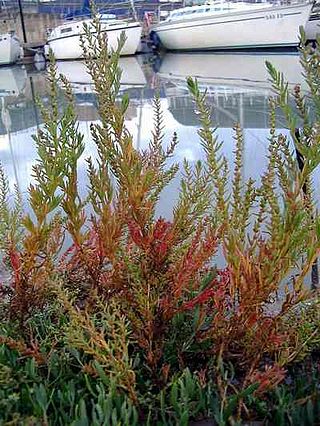
The Lamiaceae or Labiatae are a family of flowering plants commonly known as the mint, deadnettle or sage family. Many of the plants are aromatic in all parts and include widely used culinary herbs like basil, mint, rosemary, sage, savory, marjoram, oregano, hyssop, thyme, lavender, and perilla, as well as other medicinal herbs such as catnip, salvia, bee balm, wild dagga, and oriental motherwort. Some species are shrubs, trees, or, rarely, vines. Many members of the family are widely cultivated, not only for their aromatic qualities, but also their ease of cultivation, since they are readily propagated by stem cuttings. Besides those grown for their edible leaves, some are grown for decorative foliage. Others are grown for seed, such as Salvia hispanica (chia), or for their edible tubers, such as Plectranthus edulis, Plectranthus esculentus, Plectranthus rotundifolius, and Stachys affinis. Many are also grown ornamentally, notably coleus, Plectranthus, and many Salvia species and hybrids.

The rose subfamily Rosoideae consists of more than 850 species, including many shrubs, perennial herbs, and fruit plants such as strawberries and brambles. Only a few are annual herbs.
Bunge Global SA (BUN-ghee) is a global agribusiness and food company, incorporated in Geneva, Switzerland and headquartered in St. Louis, Missouri, United States.

Matthiola is a genus of flowering plant in the mustard family Brassicaceae. It is named after Italian naturalist Pietro Andrea Mattioli (1501–1577). The genus contains about 50 species of annual, biennial and perennial herbaceous plants and subshrubs. Many are cultivated for their heavily scented, colorful flowers.

Suaeda is a genus of plants also known as seepweeds and sea-blites. Most species are confined to saline or alkaline soil habitats, such as coastal salt-flats and tidal wetlands. Many species have thick, succulent leaves, a characteristic seen in various plant genera that thrive in salty habitats.

Zygophyllum is the type genus of the flowering plant family Zygophyllaceae. The generic name is derived from the Greek words ζυγόν (zygon), meaning "double", and φυλλον (phyllon), meaning "leaf". It refers to the leaves, each of which have two leaflets.

Corispermum is a genus of plants in the family Amaranthaceae. Common names given to members of the genus involve bugseed, tickseed, and tumbleweed. In general, these are erect annual plants with flat, thin leaves and topped with inflorescences of flowers with long bracts. Bugseeds are native to North America and Eurasia, but little is known about their taxonomy and distribution.
Smirnowia is a genus of flowering plants in the legume family, Fabaceae. It contains a single species, Smirnowia turkestana, a perennial shrub native to Afghanistan, Iran, Turkmenistan, and Uzbekistan. It belongs to the subfamily Faboideae.

Haloxylon is a genus of shrubs or small trees, belonging to the plant family Amaranthaceae. Haloxylon and its species are known by the common name saxaul. "Saksaul" is a common Turkic word that entered Russian through Kazakh.
Astragalus bakaliensis is a species of flowering plant in the large legume genus Astragalus (Fabaceae). It is native to central Asia, Iran, and Pakistan. Astragalus bakaliensis was first formally named by Russian botanist Alexander von Bunge in 1851.
Bothriospermum is a genus of flowering plants belonging to the family Boraginaceae.
Chartoloma is a genus of flowering plants belonging to the family Brassicaceae.
Cithareloma is a genus of flowering plants belonging to the family Brassicaceae.
Halocharis is a genus of flowering plants belonging to the family Amaranthaceae.
Halarchon vesiculosus is a species of flowering plant belonging to the family Amaranthaceae.It is the sole species in genus Halarchon. It is an annual native to Afghanistan.

Liebigia is a genus of flowering plants belonging to the family Gesneriaceae.

Oresitrophe rupifraga is a species of flowering plant belonging to the family Saxifragaceae. It is the sole species in genus Oresitrophe. It is a perennial native to northern China, ranging from eastern Shanxi Province to western Liaoning Province.
Pentapeltis is a genus of flowering plants belonging to the family Apiaceae.

Petrosimonia is a genus of flowering plants belonging to the family Amaranthaceae. It is also in the Salsoloideae tribe.

Halimocnemis is a genus of flowering plants belonging to the family Amaranthaceae.











